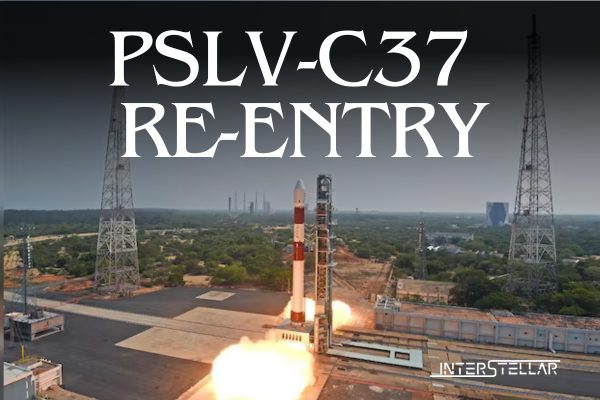PSLV-C37 Upper Stage Re-Enters Earth’s Atmosphere After Historic 2017 Launch
The upper stage of the PSLV-C37 rocket, which set a record by launching 104 satellites in one mission, re-entered Earth’s atmosphere on 6 October 2024. This re-entry signifies an important milestone in space debris management. It adheres to international guidelines and highlights the Indian Space Research Organisation’s (ISRO) commitment to sustainable space operations.
Record-Breaking Launch and Mission Overview
On 15 February 2017, ISRO’s Polar Satellite Launch Vehicle (PSLV-C37) made history by deploying 104 satellites in a single launch. The primary payload was the Cartosat-2D satellite, along with 103 co-passenger satellites. These included INS-1A, INS-1B, Al-Farabi 1, BGUSAT, DIDO-2, Nayif 1, PEASS, 88 Flock-3p satellites, and 8 Lemur-2 satellites. This achievement demonstrated ISRO’s expertise in satellite deployment and reinforced its leadership in space technology.
Details of PSLV-C37 Upper Stage Re-Entry
After the satellites were successfully deployed, the upper stage (PS4) remained in an orbit of around 470 x 494 km. Since then, atmospheric drag caused a gradual decay in its altitude. The US Space Command (USSPACECOM) continuously tracked the PS4 stage, assigning it the NORAD ID 42052.
On 6 October 2024, at 15:49 UTC, the PSLV-C37 upper stage re-entered Earth’s atmosphere over the North Atlantic Ocean. The USSPACECOM predicted this re-entry with a margin of error of +/- 1 minute. ISRO’s own prediction through the ISRO System for Safe and Sustainable Space Operations Management (IS4OM) estimated the re-entry at 15:48:25 UTC, showcasing their precise tracking capabilities.
Compliance with International Space Debris Guidelines
The re-entry of PSLV-C37’s upper stage took place within eight years of its launch. This timeframe aligns with the Inter-Agency Space Debris Coordination Committee’s (IADC) guideline, which limits post-mission orbital life of defunct objects in Low-Earth Orbit (LEO) to 25 years. ISRO achieved this by implementing a passivation sequence that lowered the orbit of the PS4 stage after satellite deployment.
ISRO aims to further reduce the orbital lifetime of PSLV upper stages to 5 years or less for future missions. This goal will be accomplished by using engine re-starts to lower orbits, as demonstrated in recent missions like PSLV-C38, PSLV-C40, PSLV-C43, PSLV-C56, and PSLV-C58. Additionally, ISRO is considering controlled re-entries for future upper stages to ensure safer disposal.
Future Steps Towards Sustainable Space Operations
As part of its long-term commitment to outer space sustainability, ISRO aims to achieve its Debris Free Space Mission (DFSM) objectives by 2030. This initiative involves taking proactive steps to reduce space debris and adhere to international standards. ISRO’s ongoing efforts reflect its dedication to maintaining a clean and safe space environment for future missions.


